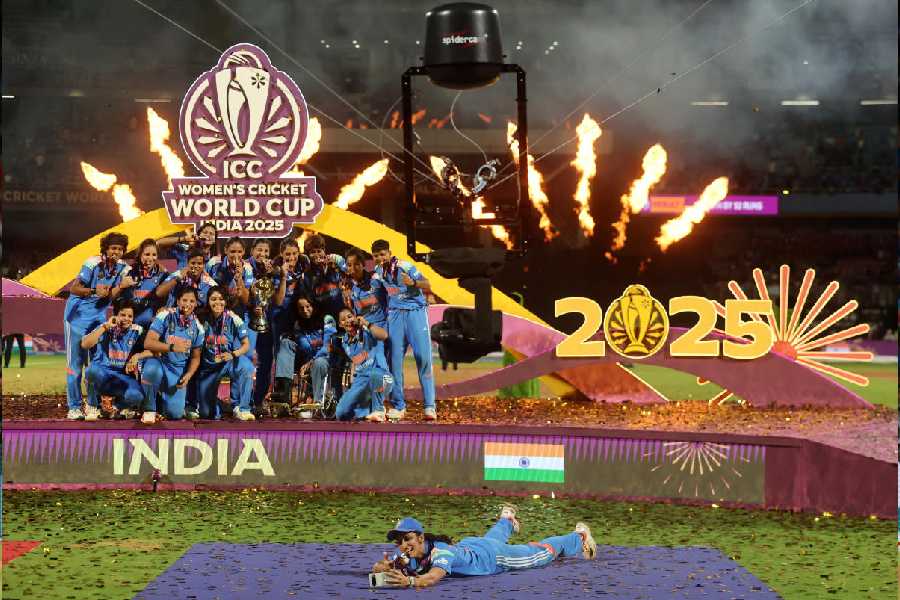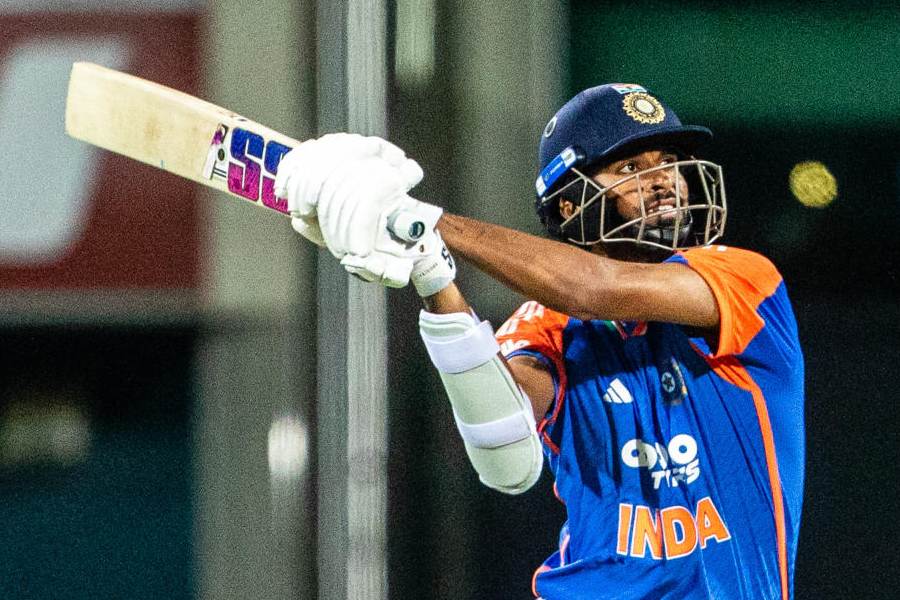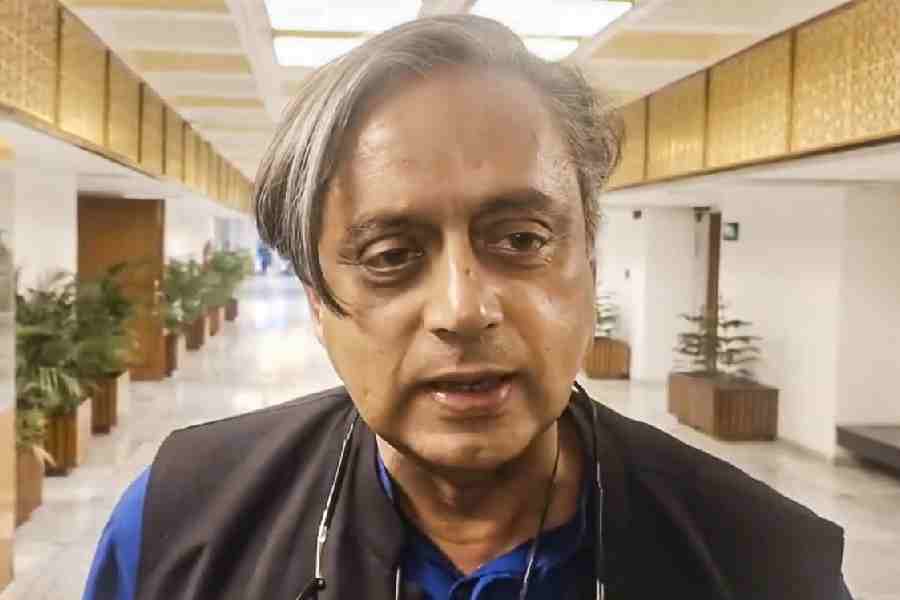 |
| Mayookh Bhaumik has learnt his trade from gurus like Pandit Gyan Prakash Ghosh and Ustad Sabir Khan. Pic by Subhendu Chaki |
Tabla player Aditya Kalyanpur’s fingers are a blur. The 31-year-old musician, who’s making a name for himself in double-quick taal, is about to embark on a multi-city tour of the United States with a band of 20 musicians. He’s also keeping up the fast-paced tempo in other ways and is bringing out a fusion album in collaboration with two American musicians and Indian vocalist Sayali Oak. Says Kalyanpur: “We’re drawing influences from West African Mande traditions, American jazz and blues and Indian classical music. And we’re taking traditional instruments like the tabla and putting it into a modern context.”
Calcutta-based Anubrata Chatterjee, 25, is also working his fingers at high speed. He’s touring the US this summer and he’ll also be playing with sarod maestro Amjad Ali Khan and his sons during the tour. Before that, in March, he’ll be playing a duet with his father (veteran tabla player Anindo Chatterjee) in Varanasi. In between he will also be teaming with sarod player Purbayan Chatterjee and playing with his band String Struck. The two musicians will be doing a series of fusion gigs in Imphal, Bangalore and Delhi.
Kalyanpur and Chatterjee are part of a posse of young tabla players who are moving their fingers in double-quick time and making a name for themselves in the highly discriminating world of Indian music. Says Kalyanpur: “We are only following in the footsteps of our mentors like Ustad Alla Rakha Khan and Zakir Hussain who have already taken the tabla to the highest level. We are trying to contemporise it in the modern context.”
 |
 |
| (From top) Aditya Kalyanpur’s fusion album will blend Indian classical with West African music and American jazz and blues; the Darbar Festival in London in April will see Satyajit Talwalkar in a solo act. Pix by Gajanan Dudhalkar |
Take a look at New Jersey-born and Calcutta-based tabla player, Mayookh Bhaumik, who’s also globetrotting this year and playing in swift succession at the Montreal Jazz Festival and the Atlantic Jazz Festival in July. He’ll also be accompanying dancer Bhairavi Kumar in Los Angeles and accompanying sitarist Ustad Shujaat Khan. Bhaumik was hailed as a child prodigy when he was a four-year-old toddler by Ustad Ali Akbar Khan and came to India to learn with gurus like Pandit Gyan Prakash Ghosh and Ustad Sabir Khan. Currently, he is taking lessons under Zakir Hussain.
It’s a similar story for 35-year-old Subhajyoti Guha, who’s also focusing on experimenting with newer sounds in tabla and who started beating out rhythms when he was just five years old. He trained under Pandit Sankha Chatterjee of the Punjab gharana.
And success came early for 31-year-old Satyajit Talwalkar, who’s the son of Suresh (tabla maestro) and Padma (vocalist) Talwalkar. He’ll be playing solo at the Darbar Festival in London in April and also accompanying classical musicians like sitarist Kushal Das and vocalist Kaivalya Kumar (vocalist).
Satyajit admits that playing the tabla was almost a natural thing for him because of his home environment. “There was a natural fondness towards the tabla because I grew up watching my father play at home,” he says.
Forced by changing times, these tabla players are embracing change and exploring newer alternatives like fusion music and band music with gusto. So Kalyanpur is currently the frontman of his fusion band, Fuzikk, and also a member of the band, Bombay Jazz, which also includes jazz legends Larry Coryell, George Brooks and flute maestro Pandit Ronu Majumdar.
Bhaumik has his own five-member band Black Coffee that plays fusion music. And, Guha who shuttles between Toronto and Calcutta has his own band called Maya, based in Toronto. In May, he will be performing at the world music festival called Desi Fest in Canada. Meanwhile, Talwalkar too plays tabla in sitarist Niladri Kumar’s fusion band called Sitar Funk while Chatterjee plays tabla in sitarist Purbayan Chatterjee’s band, String Struck, and also jams with percussionists Bickram Ghosh and Taufiq Qureshi.
 |
 |
| (From top) Subhajyoti Guha has his own band called Maya, based in Toronto; she’s only 21, but Rimpa Siva has already played in over 500 concerts and she stands out in the male-dominated world of tabla players |
Why are they beating out different rhythms? The answer’s quite clear. Today, many classical musicians have realised that in order to reach out to a wider audience it is necessary to come out with newer work. Take for instance Chatterjee who has started doing percussion. He says, “I am trying to give an electronica feel to the tabla. Till now using electronica happened in music recordings but to incorporate that in a live performance is something new.”
He’s also about to start learning how to play kick-drums (a pedal-operated bass drum) and will soon be travelling to New York to find a teacher who can instruct him on playing the instrument. Apart from that, he also plays the khanjira (a south-Indian percussion instrument) and the tambourine.
At a slightly different level is 21-year-old Rimpa Siva, the one-of-a-kind, youthful, female tabla wizard who’s already made record of sorts by performing in over 500 classical music concerts worldwide. She started playing the tabla as a three-year-old under her father Swapan Siva. When she was 14, she first accompanied Pandit Hari Prasad Chaurasia on a concert tour to the US and since then she has been playing with musical stalwarts like Pandit Jasraj and Ajoy Chakraborty. In 1999, a 26-minute documentary film titled Rimpa Siva: Princess of Tabla was made in France about the child prodigy.
“The tabla has always been a male-dominated instrument but I want to break the preconceptions associated with it,” says Siva, who has received critical acclaim for her incredible speed and control over the instrument. She has done her M.A. from Rabindra Bharati University in Calcutta and is currently studying for a Ph. D in musicology.
There are, of course, differing views on whether Indian musicians should be focusing on fusion music. Many classical musicians frown on these deviations from the old ways of doing things and making music. But others are less censorious and agree that the younger generation is innovating because they want to investigate new sounds —and for sheer survival.
Says tabla player and percussionist Bickram Ghosh: “Keeping in mind today’s times, a tabla player cannot limit himself to just playing the tabla. Once you master the traditional technique there are endless possibilities you can try out.”
Many of these aspiring stars have been fast tracked in their careers because their parents were either tabla players or had a musical background. Subhjyoti, for instance, was introduced to the world of the tabla at the age of five by his father Smriti Ranjan Guha. “As a kid growing up, I had an aptitude for rhythm and therefore my father took me to Guruji to learn the tabla. Years later, when I was in Class IX, I attended a tabla duet of Ustad Alla Rakha Khan and Zakir Hussain in Calcutta and was blown away by the awesome performance. After that, I was convinced about my calling,” says Subhajyoti.
But even if they didn’t come from tabla-playing homes, the others did make a mark quite early in life. After establishing his skills as a tabla player, Bhaumik also took extensive training in Carnatic music under mridangam player S. Shekhar and in 2003 created an instrument called the mridangam tabla (he mounted the head of the mridangam on the tabla).
 |
| Anubrata Chatterjee in a concert with Amjad Ali Khan |
Making it big as a musician can, of course, be a tough game. So, the youngsters have widened their career options. So while Kalyanpur keeps himself busy by teaching tabla in his own school in the US called the New England School of Music, Guha also teaches in his Pushpak Music and Dance Academy in Toronto.
At a slightly different level, Chatterjee takes tabla classes online at www.esishya.com. Meanwhile, there’s Talwalkar who has worked with composers Aadesh Srivastava and A.R. Rahman and Bhaumik who has composed music for Suman Mukhopadhyay’s Herbert and his film-maker brother Mainak Bhaumik’s Aamra in Bengali.
So what’s the future for these talented musicians? Tabla exponent Tanmoy Bose, who has come out with a fusion album Baul N Beyond, sums up the possibilities: “The future looks extremely bright for these young artists but they still have a long way to go. A musician should be multi-dimensional in today’s time. But what is scary is the fact that many of the young classical musicians are taking the band route to instant stardom. Though there is nothing wrong in playing in a band they should understand at the same time that classical music is about hardcore taalim and riyaz.”
Certainly, senior musicians are optimistic about the youngsters. Says vocalist Ajoy Chakraborty: “They have very good tonal quality and as they gain experience their style will get more refined. I am happy that tabla players are gaining importance.'
Agrees sarod player Tejendra Narayan Majumdar: “Today’s tabla players should make their own identity and keep their focus correct.”
But will they make fusion music a priority? Chatterjee says, “Fusion music should not be the be-all and end-all for classical musicians. Playing tabla without being gimmicky should be our objective. At the same time, we should also try to diversify and experiment with other genres of music.”










